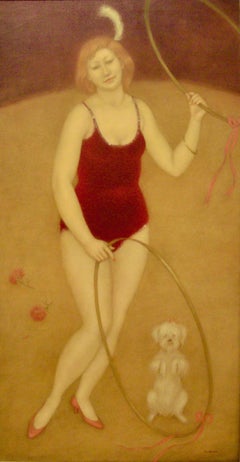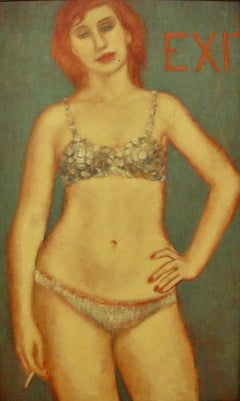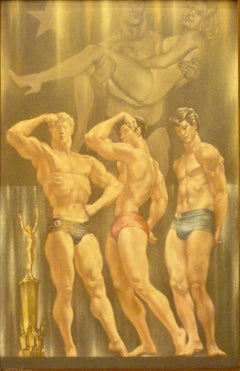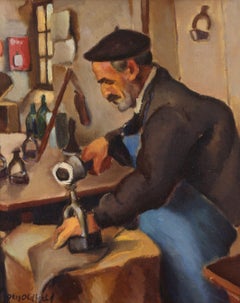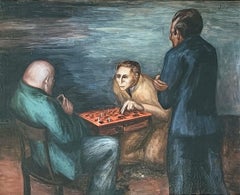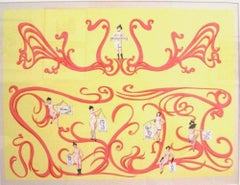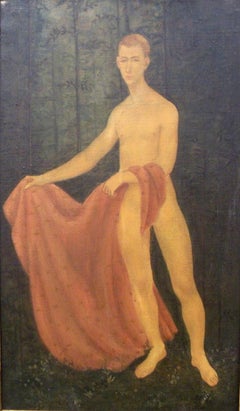Jack Henderson Art
to
2
3
3
3
3
Jack Henderson, Circus
By Jack Henderson
Located in New York, NY
This painting is signed at the lower right. The frame adds a few inches to the size and was selected by the artist.
Jack Henderson (1931-1998) taught at the Art Students League for many years and had a studio in at 30 East 14th Street, New York City. In that building were many other artists including Henderson's teacher and long-time collaborator, Edward Laning. A Kansas City native, Henderson was the recipient of a Fulbright Fellowship and a Fellow of the American Academy in Rome. He continued the Miller/Laning tradition of travel to Italy to study the masters of the Renaissance and the goal of fine figure painting as the ultimate artistic achievement. A version of his monumental triptych, New York in Ruin, 1967, is in the collection of the New York Landmarks Commission. Work by Jack Henderson was shown at the Susan Teller Gallery...
Category
1960s American Realist Jack Henderson Art
Materials
Oil
$4,800 Sale Price
20% Off
Jack Henderson, Exit
By Jack Henderson
Located in New York, NY
The frame adds a few inches to the size and was selected by the artist.
Jack Henderson (1931-1998) taught at the Art Students League for many years and had a studio in at 30 East 14th Street, New York City. In that building were many other artists including Henderson's teacher and long-time collaborator, Edward Laning. A Kansas City native, Henderson was the recipient of a Fulbright Fellowship and a Fellow of the American Academy in Rome. He continued the Miller/Laning tradition of travel to Italy to study the masters of the Renaissance and the goal of fine figure painting as the ultimate artistic achievement. A version of his monumental triptych, New York in Ruin, 1967, is in the collection of the New York Landmarks Commission. Work by Jack Henderson was shown at the Susan Teller Gallery...
Category
1960s American Realist Jack Henderson Art
Materials
Oil
$4,800 Sale Price
20% Off
Jack Henderson, The Winners
By Jack Henderson
Located in New York, NY
The frame adds a few inches to the size and was selected by the artist.
Jack Henderson (1931-1998) taught at the Art Students League for many years and had a studio in at 30 East 14th Street, New York City. In that building were many other artists including Henderson's teacher and long-time collaborator, Edward Laning. A Kansas City native, Henderson was the recipient of a Fulbright Fellowship and a Fellow of the American Academy in Rome. He continued the Miller/Laning tradition of travel to Italy to study the masters of the Renaissance and the goal of fine figure painting as the ultimate artistic achievement. A version of his monumental triptych, New York in Ruin, 1967, is in the collection of the New York Landmarks Commission. Work by Jack Henderson was shown at the Susan Teller Gallery...
Category
1960s American Realist Jack Henderson Art
Materials
Oil
Related Items
"Old Shoemaker" Ashcan 20th Century Modernism 1924 California WPA Realism Worker
By Otis Oldfield
Located in New York, NY
"Old Shoemaker" Ashcan 20th Century Modernism 1924 California WPA Realism Worker. Signed “Otis Oldfield” lower left. 14 x 12 inches.
Exhibited: Galerie des Beaux Arts, San Francisco, CA, 1925
Provenance: Estate of the Artist
Born in Sacramento, CA on July 3, 1890, Otis Oldfield left high school at age 16 to work in a local print shop. In 1909 he arrived in San Francisco and enrolled at the Best Art School. After working for two years as a bellhop at the Argonaut Hotel and as a hat check boy at the Cliff House, he had saved enough money for further studies in Paris. In 1911 he sailed for France and enrolled at Académie Julian. Caught up in the activities of wartime Paris, he was an apprentice for a book...
Category
1920s American Realist Jack Henderson Art
Materials
Canvas, Oil
Chess Players WPA Depression Era Mid-20th Century American Scene Realism Modern
By Mervin Jules
Located in New York, NY
Chess Players WPA Depression Era Mid-20th Century American Scene Realism Modern. Signed upper right and verso 8 x 10 inches oil on board.
BIO
The son of a men's haberdasher, Mervin ...
Category
1930s American Realist Jack Henderson Art
Materials
Oil, Board
$6,800
H 10 in W 12 in D 2 in
Standing Figure - Mid-Century American Portrait Painting
Located in Marco Island, FL
Mid-century city life is captured in this Clyde Singer portrait, Standing Figure, where he depicts a woman posing in 1954. An accomplished American Scene painter, Singer successful...
Category
1950s American Realist Jack Henderson Art
Materials
Oil, Board
'Sketching Wisconsin' original oil painting, Signed
By John Steuart Curry
Located in Milwaukee, WI
John Steuart Curry
"Sketching Wisconsin," 1946
oil on canvas
31.13 x 28 inches, canvas
39.75 x 36.75 x 2.5 inches, frame
Signed and dated lower right
Overall excellent condition
Presented in a 24-karat gold leaf hand-carved wood frame
John Steuart Curry (1897-1946) was an American regionalist painter active during the Great Depression and into World War II. He was born in Kansas on his family’s farm but went on to study art in Chicago, Paris and New York as young man. In Paris, he was exposed to the work of masters such as Peter Paul Rubens, Eugène Delacroix and Jacques-Louis David. As he matured, his work showed the influence of these masters, especially in his compositional decisions. Like the two other Midwestern regionalist artists that are most often grouped with him, Grant Wood (American, 1891-1942) and Thomas Hart Benton (American, 1889-1975), Curry was interested in representational works containing distinctly American subject matter. This was contrary to the popular art at the time, which was moving closer and closer to abstraction and individual expression.
Sketching Wisconsin is an oil painting completed in 1946, the last year of John Steuart Curry’s life, during which time he was the artist-in-residence at the University of Wisconsin in Madison. The painting is significant in Curry’s body of work both as a very revealing self-portrait, and as a landscape that clearly and sensitively depicts the scenery of southern Wisconsin near Madison. It is also a portrait of the artist’s second wife, Kathleen Gould Curry, and is unique in that it contains a ‘picture within a picture,’ a compositional element that many early painting masters used to draw the eye of the viewer. This particular artwork adds a new twist to this theme: Curry’s wife is creating essentially the same painting the viewer is looking at when viewing Sketching Wisconsin.
The triangular composition of the figures in the foreground immediately brings focus to a younger Curry, whose head penetrates the horizon line and whose gaze looks out towards the viewer. The eye then moves down to Mrs. Curry, who, seated on a folding stool and with her hand raised to paint the canvas on the easel before her, anchors the triangular composition. The shape is repeated in the legs of the stool and the easel. Behind the two figures, stripes of furrowed fields fall away gently down the hillside to a farmstead and small lake below. Beyond the lake, patches of field and forest rise and fall into the distance, and eventually give way to blue hills.
Here, Curry has subverted the traditional artist’s self-portrait by portraying himself as a farmer first and an artist second. He rejects what he sees as an elitist art world of the East Coast and Europe. In this self-portrait he depicts himself without any pretense or the instruments of his profession and with a red tractor standing in the field behind him as if he was taking a break from the field work. Here, Curry’s wife symbolizes John Steuart Curry’s identity as an artist. Compared with a self-portrait of the artist completed a decade earlier, this work shows a marked departure from how the artist previously presented and viewed himself. In the earlier portrait, Curry depicted himself in the studio with brushes in hand, and with some of his more recognizable and successful canvases behind him. But in Sketching Wisconsin, Curry has taken himself out of the studio and into the field, indicating a shift in the artist’s self-conception.
Sketching Wisconsin’s rural subject also expresses Curry’s populist ideals, that art could be relevant to anyone. This followed the broad educational objectives of UW’s artist-in-residence program. Curry was appointed to his position at the University of Wisconsin in 1937 and was the first person to hold any such position in the country, the purpose of which was to serve as an educational resource to the people of the state. He embraced his role at the University with zeal and not only opened the doors of his campus studio in the School of Agriculture to the community, but also spent a great deal of time traveling around the state of Wisconsin to visit rural artists who could benefit from his expertise. It was during his ten years in the program that Curry was able to put into practice his belief that art should be meaningful to the rural populace. However, during this time he also struggled with public criticism, as the dominant forces of the art market were moving away from representation. Perhaps it was Curry’s desire for public acceptance during the latter part of his career that caused him to portray himself as an Everyman in Sketching Wisconsin.
Beyond its importance as a portrait of the artist, Sketching Wisconsin is also a detailed and sensitive landscape that shows us Curry’s deep personal connection to his environment. The landscape here can be compared to Wisconsin Landscape of 1938-39 (the Metropolitan Museum of Art), which presents a similar tableau of rolling hills with a patchwork of fields. Like Wisconsin Landscape, this is an incredibly detailed and expressive depiction of a place close to the artist’s heart. This expressive landscape is certainly the result of many hours spent sketching people, animals, weather conditions and topography of Wisconsin as Curry traveled around the state. The backdrop of undulating hills and the sweeping horizon, and the emotions evoked by it, are emphatically recognizable as the ‘driftless’ area of south-central Wisconsin. But while the Metropolitan’s Wisconsin Landscape conveys a sense of uncertainty or foreboding with its dramatic spring cloudscape and alternating bands of light and dark, Sketching Wisconsin has a warm and reflective mood. The colors of the foliage indicate that it is late summer and Curry seems to look out at the viewer approvingly, as if satisfied with the fertile ground surrounding him.
The landscape in Sketching Wisconsin is also revealing of what became one of Curry’s passions while artist-in-residence at UW’s School of Agriculture – soil conservation. When Curry was a child in Kansas, he saw his father almost lose his farm and its soil to the erosion of The Dust Bowl. Therefore, he was very enthusiastic about ideas from UW’s School of Agriculture on soil conservation methods being used on Wisconsin farms. In Sketching Wisconsin, we see evidence of crop rotation methods in the terraced stripes of fields leading down the hillside away from the Curry’s and in how they alternate between cultivated and fallow fields.
Overall, Sketching Wisconsin has a warm, reflective, and comfortably pastoral atmosphere, and the perceived shift in Curry’s self-image that is evident in the portrait is a positive one. After his rise to favor in the art world in the 1930’s, and then rejection from it due to the strong beliefs presented in his art, Curry is satisfied and proud to be farmer in this self-portrait. Curry suffered from high blood...
Category
1940s American Realist Jack Henderson Art
Materials
Canvas, Oil
$652,500
H 39.75 in W 36.75 in D 2.5 in
UNION SQUARE Depression Era Oil Painting WPA Realism American Scene Realism NYC
By Jo Cain
Located in New York, NY
UNION SQUARE Depression Era Oil Painting WPA Realism American Scene Realism NYC
Jo Cain (1904 – 2003)
"Union Square"
24 x 36 inches
Oil on canvas, c.1940s
S...
Category
1940s American Realist Jack Henderson Art
Materials
Canvas, Oil
$33,000
H 31 in W 43 in D 2 in
"Summer Pier Fishing" American Scene Social Realism WPA Mid-20th Century Modern
Located in New York, NY
"Summer Pier Fishing" American Scene Social Realism WPA Mid-20th Century Modern
Syd J. Browne (1907-1991)
"Summer Pier Fishing"
22 x 30 inches
Oil on canvas. c. 1930s
Signed lower r...
Category
1930s American Realist Jack Henderson Art
Materials
Canvas, Oil
Palace Bar
By Paul G. Oxborough
Located in Greenwich, CT
Signed upper right
Unframed dimensions: 21 x 28 inches
Framed dimensions: 28 1/2 x 36 1/2 inches
Paul G. Oxborough studied at Minneapolis College of Art and Design and Atelier Lesue...
Category
2010s American Realist Jack Henderson Art
Materials
Linen, Oil
Under the Viaduct American Scene Social Realism WPA Era Mid-20th Century Modern
Located in New York, NY
Under the Viaduct American Scene Social Realism WPA Era Mid-20th Century Modern
Syd J. Browne (1907-1991)
Under the Viaduct
22 x 30 inches
Oil on canvas. c. 1930s
Signed lower left
...
Category
1930s American Realist Jack Henderson Art
Materials
Canvas, Oil
Girl Reading Card-American Realist Portrait-Mid-Century Original Oil Painting
Located in Marco Island, FL
Clyde Singer was a master of capturing the small and significant moments of everyday life. This painting, titled Girl Reading Card, 1948, is one of those perfect scenes that he docu...
Category
1940s American Realist Jack Henderson Art
Materials
Masonite, Oil
Market Woman- American Regionalist Oil Painting of Mid-Century City Life
Located in Marco Island, FL
Mid-century city life is captured in this Clyde Singer painting, Market Woman, where he depicts a woman with her shopping in 1955. An accomplished American Scene painter, Singer su...
Category
1950s American Realist Jack Henderson Art
Materials
Oil, Board
$8,000
H 23.5 in W 15 in D 2 in
Victory
Located in Ibadan, Oyo
"Victory" emanates a sense of vibrancy and vitality, drawing viewers into its world of anticipation and celebration. The central figure, depicted with a wide grin and laughter lines ...
Category
21st Century and Contemporary American Realist Jack Henderson Art
Materials
Canvas, Mixed Media, Oil, Acrylic
Industrial Mural Study, Veterans Memorial Building, Santa Barbara WPA American
Located in New York, NY
Industrial Mural Study, Veterans Memorial Building, Santa Barbara WPA American
Joseph Edward Knowles (1907-1980)
"Study for Industry Mural, Veterans Memorial Building, Santa Barbara, CA"
19 1/2 x 50 1/2 inches
Oil on board, c. 1930s.
Estate stamp verso
Framed: 27 x 60 inches
The completed mural is currently hanging on the wall, part of the building actually, at the Veterans Memorial Building in Santa Barbara. A photo of the work insitu is included in the attached photos.
BIO
Joseph Edward Knowles was born in Kendall, Montana, on June 15, 1907. He grew up in San Diego, California. At age twenty, two years before the beginning of the Great Depression, he moved north to another town on the coast of California---Santa Barbara. There he began studying fine art at the Santa Barbara School of the Arts* (1927-1930), under the supervision of Frank Morley Fletcher, previously director of the Edinburgh College of Art. Fletcher, who was trained in portraiture, landscape painting, and woodblock* printing, was a great influence on young Knowles. It was there that Knowles learned the art of color woodblock printmaking, a medium in which he showed great skill.
Not long after completing his studies with Fletcher, Knowles began teaching art. For a period of thirty years, from 1930 to1960, he taught at the Cate School in Carpinteria, California. In 1934-1935, Knowles traveled throughout Europe, further developing his artistic skills in England, France, and Italy. Upon his return, he continued to teach art at various schools and institutions: Cate School, Crane Country School, extension classes at the University of California at Santa Barbara (UCSB), and at the Santa Barbara Museum of Art (SBMA). Knowles also served as an art education consultant for the County of Santa Barbara. In addition, he was founding co-director and president of the Santa Barbara Fine Arts Institute (1969-1972), which later developed a specialization in photography and became the Brooks Institute of Photography. Knowles died at his home in Santa Barbara on September 8, 1980.
Much of Knowles' watercolor work is associated with what has been termed the "California School*," a loose grouping of artists throughout the state that included such figures as Millard Sheets, Phil Dike, Dong Kingman, George Post, and the Santa Barbara painters Dan Lutz and Standish Backus, Jr. The California School artists, including Knowles, were known for their fresh, direct, spontaneous style of watercolor painting. Knowles and other members of the school found inspiration in nature and the built environment alike, emphasizing elements of design in their exuberant, boldly stated, colorful scenes from everyday life. While painting in a representational* manner, Knowles generally avoided photographic realism, preferring subjective interpretation of his subjects. In this, as well as in his experimental approach and vigorous brushwork, he displayed a strongly modern sensibility.
Knowles often used the wet-on-wet watercolor technique as he painted seascapes and landscapes, mostly along the California coast. He also employed dry-brush* techniques in many of his paintings, often leaving some of the white of the watercolor paper exposed. Some of the latter depict trees and other forms in a broken and airy manner that recalls Cezanne.
Knowles' colored woodblock prints are more reserved and exact in their draftsmanship than his paintings. Spare, clean, lyrical lines are drawn to illustrate floral motifs and boat scenes with a touch of asymmetry conjuring Japanese woodblock prints. His murals from the post-World War II period are considerably more modern in their approach and show an emphasis on design and color.
PROFESSIONAL ORGANIZATIONS
California Watercolor Society (1940 - 1955)
Santa Barbara Art Association (Vice President - 1952)
ONE-MAN EXHIBITIONS
Golden Gate International Exposition (GGIE) - San Francisco, California
San Diego Fine Arts Gallery (SDMA) - San Diego, California
Santa Barbara Museum of Art (SBMA) - Santa Barbara, California
Cowie Galleries - Los Angeles, California
Gallery de Silva - Santa Barbara, California
Bradley Galleries - Santa Barbara, California
MURALS
Westmont College - Ellen Porter Hall Mural - Santa Barbara, California
Safeway Grocery (now Vons Grocery on West Victoria Street) - Exterior Tile Mosaic -
Santa Barbara, California
Santa Barbara Bank & Trust - Interior Mosaic Panels, Santa Barbara, California
Santa Barbara Girls Club - Interior Mosaic Mural - Santa Barbara, California
Ernest Righetti High School - Mosaic Mural - Santa Maria, California
Shell Oil Company - Mosaic Panel - California
Beckman Instruments, Corporate Headquarters - Mosaic - Fullerton, California
STAINED GLASS WINDOWS, WALLS and PANELS
Katherine Thayer Cate Memorial Chapel - Cate School, Carpinteria, California
William S. Porter Memorial Chapel - Cottage Hospital, Santa Barbara, California
La Rinconada Building - Santa Barbara, California
ILLUSTRATIONS
"California's Wonderful Corner: True Stories for Children from the History of the Santa Barbara Region," by Walter A. Tompkins (1962 & 1975)
China Designs:
Two sets of dinnerware for Winfield China...
Category
1930s American Realist Jack Henderson Art
Materials
Oil, Board
Previously Available Items
Kaleidoscope
By Jack Henderson
Located in New York, NY
This lyrical drawing on board might have been made for A La Carte Fashions, 21 East 63rd Street, NYC, a women's dress shop for which Henderson was a store and window designer. It is signed in ink on the reverse. It is signed in ink on the reverse.
Jack Henderson...
Category
Mid-20th Century American Modern Jack Henderson Art
Materials
Gouache
Young Male Model with Red Drape
By Jack Henderson
Located in New York, NY
The antique frame (with some damage) adds a few inches to the size and was selected by the artist.
Jack Henderson (1931-1998) taught at the Art Students League for many years and had a studio in at 30 East 14th Street, New York City. In that building were many other artists including Henderson's teacher and long-time collaborator, Edward Laning. A Kansas City native, Henderson was the recipient of a Fulbright Fellowship and a Fellow of the American Academy in Rome. He continued the Miller/Laning tradition of travel to Italy to study the masters of the Renaissance and the goal of fine figure painting as the ultimate artistic achievement. A version of his monumental triptych, New York in Ruin, 1967, is in the collection of the New York Landmarks Commission. Work by Jack Henderson was shown at the Susan Teller Gallery...
Category
1950s American Realist Jack Henderson Art
Materials
Oil
Jack Henderson art for sale on 1stDibs.
Find a wide variety of authentic Jack Henderson art available for sale on 1stDibs.
